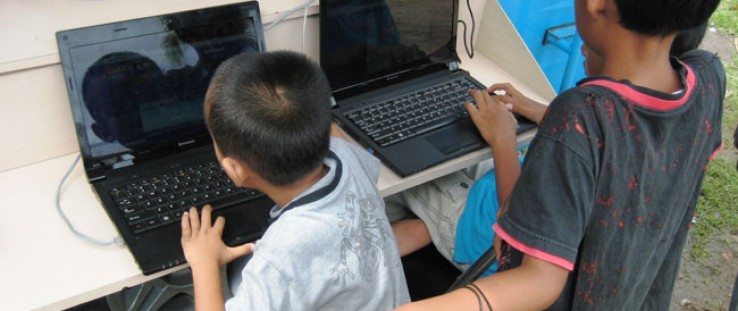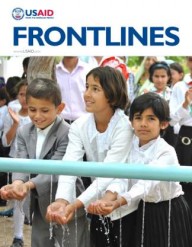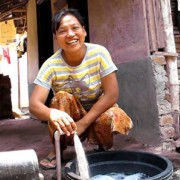 Kids access the Internet in rural West Sumatra.
Hanna Adeyema
Kids access the Internet in rural West Sumatra.
Hanna Adeyema
 Kids access the Internet in rural West Sumatra.
Hanna Adeyema
Kids access the Internet in rural West Sumatra.
Hanna Adeyema
Every month at a school in the village of Sialang on the western coast of Sumatra, one of Indonesia’s largest islands, students look forward to the arrival of a bright blue van mounted with a satellite dish.
Inside the van is something the kids, and their parents, can’t get in their schools, homes or anywhere else in town—the Internet. The vans, with six laptops each, are powered by a diesel generator and make stops at hundreds of communities and towns every month, bringing Internet access to some of Indonesia’s most out-of-the way places for the first time.
Prior to the van’s regular visits, which began in 2011, few of the village’s residents had even seen a computer firsthand, let alone used one. Now, during each of the visits, more than 60 students line up to work on their lessons and connect with friends and relatives on social media sites. The van may return several times a week, or monthly, depending on operating costs and demand in a particular village. In most visits, children can use the services from morning until 9 p.m., after which anyone else can go online, including their teachers.
The van also carries a printer, a display screen with a DVD player, a Wi-Fi adaptor and a server installed with a billing system. Users pay a small fee for the services—usually the equivalent of 11 cents (1,000 RP) to 17 cents (1,500 RP) an hour.
This effort is part of a private-sector program known locally by its acronym M-PLIK, and subsidized by the government’s Universal Service Obligation Fund. The fund was created from taxes placed on telecommunication carriers to support rural expansion of Internet access. The program is implemented by one of Indonesia’s largest telecommunications companies, P.T. Indosat—the company behind the 119 blue vans that travel to rural communities like Sialang.
Partnering for Sustainability
M-PLIK is helping advance development goals in Indonesia by leveraging private-sector and host-government funds, along with a modest USAID investment, to ensure that efforts to expand telecommunications access are sustainable and effective. The program was initially designed to reach 1,900 communities.
“M-PLIK serves as a bridge between the current state of telecommunications in rural villages and our aspirations for increased broadband and Internet access infrastructure in remote areas and small islands,” said USAID/Indonesia Mission Director Andrew Sisson. “This program also helps build demand for the service. Before telecommunication companies agree to provide service and set up infrastructure, they need to know that there is a need and a demand from consumers.”
USAID is helping the Indonesian Government’s Universal Service Obligation Fund by providing technical assistance through the Global Broadband and Innovations (GBI) program. Through GBI, USAID has performed market assessments in rural areas to determine where wireless services are most commercially viable.
Through this ongoing support, USAID hopes to obtain critical market data regarding demand for broadband that will help P.T. Indosat and the Indonesian Government determine the potential for expanding the program to other regions. This could make these projects more commercially viable as companies are able to expand to other sites.
GBI currently partners with private companies and governments in seven low-income countries to provide technical assistance for extending broadband Internet services to rural residents using low-cost wireless technology.
Haves and Have Nots
By early 2012, there were only 24 million Internet users in Indonesia—just 10 percent of the population—and less than 4 percent with access to broadband. In neighboring Malaysia, the figure is 55 percent; in China, 24 percent; and in Vietnam, 28 percent. The average in the developing world is just over 20 percent.
Indonesia’s low numbers may be due, in part, to the country’s unique features. Most of the country’s Internet users live in urban areas. But around half of the population lives in small rural villages spread across more than 17,000 islands. It is a major challenge to construct and maintain infrastructure required to support reliable and affordable Internet service, especially when there is no steady power supply in many remote areas, according to Brian Dusza, deputy director of USAID/Indonesia’s Economic Growth Office.
Before M-PLIK, people accessed the Internet by traveling to an Internet cafe in a regional capital. Although many people in rural villages have access to cell phones, they are not very useful since there is no broadband coverage, and spotty or non-existent telephone coverage.
Expanding access to Internet services is important for Indonesia’s development, country officials and leading experts say. A recent World Bank study found that a 10 percent increase in broadband penetration adds 1.38 percentage points to GDP in developing countries. When that penetration is in rural areas, it is particularly important because rural areas tend to be the last to benefit from increases in national GDP.
According to Eric G. Postel, assistant administrator for USAID’s Bureau for Economic Growth, Education and Environment, the benefits of expanding Internet access are many. “The entire world has seen how ICT can facilitate economic growth. Within the international development community there is also growing recognition of the value of information and communication technologies (ICTs) in enhancing the delivery of health, education, agriculture and other services,” he said.
On the island of Java, thanks to M-PLIK, farmers stop by to check the Web for crop information and to treat livestock diseases. Iyan, who uses just one name, is a chicken farmer who lives in Kubang, a village visited by the mobile units. He regularly uses the Internet to get information on improved chicken production techniques and chicken vaccines, and to communicate with chicken farmers in other regions of Indonesia.
In Kayu Tanan district, M-PLIK operators work with teachers so they can educate their students about how to navigate the Internet and research school projects. After school, an operator helps teachers learn how to browse the Internet, including websites that can be helpful for the classroom; use social media; and print materials. They also show teachers and high school students, ages 12 to 15, how to use some business software such as Microsoft Word, Excel and PowerPoint.
“Students and teachers reap many benefits from their time with M-PLIK. They learn that there is a new world on the Internet that includes commerce, connections to other people, and information that is useful in their daily lives,” said Zulfebriansyah, a USAID consultant participating in the GBI market assessment who uses one name. “There is a hunger and need for this access and, in fact, for further training. These mobile units have helped communities understand what the potential is and have some skill in basic computer literacy, but more can be done.”
Measuring Demand
The GBI market surveys found that there is strong demand for broadband and willingness to pay if quality value-added services such as e-commerce, online learning and e-government services are available. Many of these services are increasingly available in urban areas of Indonesia, and may be adapted to benefit rural residents.
As a result, GBI is working with the Indonesian Government to improve these services, with a focus on low-cost technologies that can be provided—through the private sector—in a commercially viable manner.
Says Postel, “The GBI program is addressing these needs through support for technical assistance to universal service funds, to ensure that they are working to maximize the spread of ICTs. In addition, the GBI is working with private-sector equipment manufacturers and carriers to deploy innovative, affordable and scalable solutions appropriate for small, rural communities.”
In Indonesia, several mobile operators are experimenting with small cells, which are part of a new generation of technologies that are radically changing the economics of delivering Internet connectivity to even the remotest areas.
These new wireless, miniature cell-tower base stations cost about 10 percent as much as their much larger conventional counterparts, and are particularly attractive for rural areas. Just a few years ago, the costs of a more conventional Internet installation could be $250,000 or more. Now, the smaller stations cost around $30,000 to $50,000, and costs are expected to continue to drop. These new technologies deliver access to smaller geographic coverage areas—between a 2- and 5-kilometer radius—which is well-suited to the typical population and size of rural villages.
For the rural communities that gain Internet access, the effect can be transformative. “People felt like they were seeing the future,” said Zulfebriansyah. “They were surprised at how much information was available and how quickly they could access it."










Comment
Make a general inquiry or suggest an improvement.